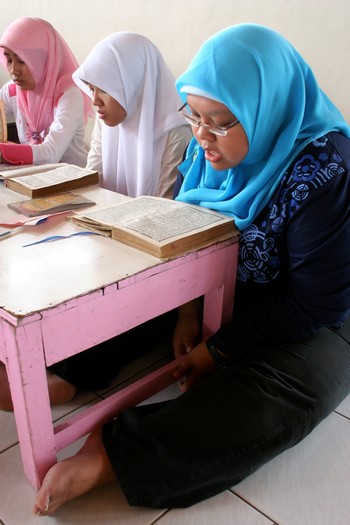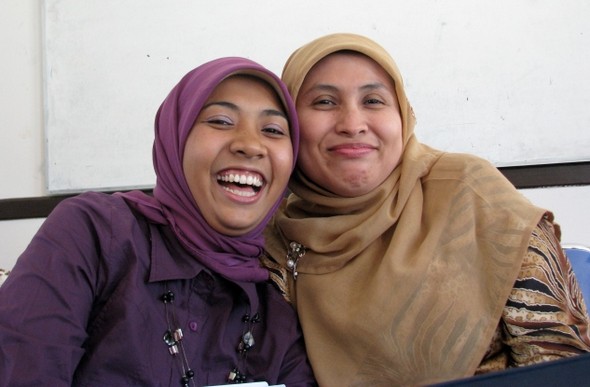Susan Blackburn
Women’s agency is central to all aspects of Islamic life in Indonesia Eve Warburton/ Aceh Research and Training Insitute
|
In Indonesia, Islam is on the march. The country has been undergoing an Islamic revival since the 1980s, and religious activity of all kinds escalated in response to the freedom created by the fall of the authoritarian New Order regime in 1998. There has been controversy about what the consequences are for women. In what ways have women benefited or suffered as a result of more Indonesians seeking to practise their religion more seriously? The articles in this issue of Inside Indonesia illustrate some of the different experiences of women during the revival. They are of great interest when one considers that Indonesia has the largest population of Muslims in the world, with almost 90 percent of its 240 million people identifying as Muslims, and that the country is now often held up to the rest of the Islamic world as an example of a moderate version of Islam.
Women and religiosity
Some of the articles in this issue document how Indonesian Muslim women are becoming more pious. In the articles by Arif Zamhari, Bianca Smith and Julian Millie we see women demonstrating a striking level of commitment in their search for religious knowledge through attending regular prayer meetings and other religious gatherings. Millie describes the lives of older women in Bandung who typically attend between four and six religious study groups a week, travelling all over town in their spiritual pilgrimages. One reason he suggest for the piety of these women is the concern they feel about social issues like corruption and rising crime: they believe that acquiring religious knowledge will help strengthen society against such perils. He contrasts the search for spiritual knowledge of these women, and the way they spread it in their families, with the religious pattern of men, who, partly because they have less time, think it enough to attend the mosque once a week.
The article by Virginia Hooker highlights the popularity of Islamic magazines for Indonesian women. The content of these magazines reflects the interests of their urban middle class buyers: they want spiritual as well as practical advice on how to live as Muslim women with a social conscience. The magazine on which Hooker focuses acknowledges that its readers are professional or semi-professional women who seek a modern form of Islam that supports their careers.
Within Indonesian Islam there are many streams, some of which are less well-known than others, including those concerned with mysticism. Since little is known about women’s involvement in these practices, we are fortunate to have here articles by Zamhari and Smith which show that women are active in these streams. Indeed, Smith’s article shows how women can be leaders within the Indonesian Sufi tradition, despite some obstacles. Such female leaders are careful not to challenge their male counterparts too openly. Zamhari focuses on a different form of mystical practice: chanting groups that are open to Muslims of all ages and sexes. The movement which he describes has specific rituals for women who are also addressed by female preachers.
Together, these articles provide us with a picture of women’s agency that is often missing in conventional discussions of Indonesian Islam. Islamic revival and Islamic piety are often depicted as being the domain of men, with little attention given to what women are doing. Nevertheless, as Millie shows, women are often more devout than men and the emergence of their religious leadership is one of the most interesting developments in Indonesia today.
Islamic feminism
People concerned about the effect on women of negative trends in Indonesian Islam have focussed on a number of developments since the end of the New Order in 1998. One is the scope provided by decentralisation for local governments to adopt discriminatory regulations under the guise of combating public immorality. Another is the proposal and passing of the Anti-Pornography Law of 2008. This law contained a sweeping definition of pornography which put many women in danger of prosecution. Many also accuse the central government of turning a blind eye to anti-woman practices and argue that polygamy is publicly tolerated in a way that it never was under the New Order, to the detriment of women. (According to the 1974 Marriage Law polygamy was restricted by various conditions most of which are now either overtly flouted or evaded by unofficial marriages – celebrated according to religious customs but not registered correctly.) Of great concern has been the decision of the central government in 2001 to allow the province of Aceh to adopt syariah law, a departure from national policy made to placate the separatist movement there.
A number of the articles in this issue raise these concerns and illustrate the efforts of some Muslim groups and individuals to contest these moves, usually adopting the argument that they are unsuited to Indonesia and derive more from Middle Eastern culture rather than being based on the spirit of Islam. According to moderate Indonesian interpretations, the religion is perfectly compatible with democracy and gender equality.
Indonesian Islam has long been distinct in various ways. One of the most striking is the existence of two huge, mass-based Islamic organisations, Muhammadiyah and Nahdlatul Islam (NU), whose origins go back to the early twentieth century. The differences between these organisations, usually seen as respectively modernist and traditionalist, have narrowed over the years, although Muhammadiyah’s membership still tends to be more urban, more national and better educated, while NU’s heartland remains the Javanese countryside. Both organisations have women’s wings which encompass millions of members and which since the 1980s have been the site of some of the most interesting developments in gender relations within Indonesian Islam.
Within these organisations have emerged a number of feminists, both male and female, who have worked hard to make them more woman-friendly and to reform misogynous discourse. This is a distinctive feature of Indonesian Islam. Two articles, by Clare Harvey and Joanne McMillan, provide us with vivid pictures of two of the impressive women leaders of this multi-faceted and historic movement. Lies Marcoes-Natsir and Farha Ciciek Asegaf have been pioneers of Islamic gender-awareness since the 1980s. The articles describe their reasons for dissatisfaction with existing interpretations of Islam. Both women were instrumental in creating space for feminist interpretations of Islam in Indonesia and for linking religion to women’s rights. They have pursued these goals through various non-government organisations that they helped to establish.
The struggle of these feminists is ongoing, but cumulatively their efforts make Indonesia unique in the Islamic world
Assisted by a number of other outstanding feminists, these two women have begun to turn around discriminatory teachings concerning women in NU’s education system. Similar reforms have been pioneered within Muhammadiyah, and have even been carried into Indonesia’s Department of Religion, by the redoubtable Siti Musdah Mulia who attempted (so far unsuccessfully) to reform the national Islamic legal code to create greater equality for women. The struggle of these feminists is ongoing, but cumulatively their efforts make Indonesia unique in the Islamic world.
Resistance to equality
Yet leaders like Lies Marcoes-Natsir and Farha Ciciek Asegaf face obstacles in their struggle for equality of Indonesian Islamic women. Apart from the opposition of hardliners in NU and Muhammadiyah, and of the vocal minority of small very conservative groups that have become more publicly visible since the fall of the New Order, there is also deeply rooted resistance in sections of society. The articles by Nina Nurmila, Eka Srimulyani, and Claudia Nef illustrate just a few of the diverse sources of this strong opposition to accepting women as equals.
Nina Nurmila shows how according to popular notions of Islam, reinforced by the Indonesian Marriage Law, only men are regarded as heads of households, making life difficult for women who are in fact the main source of support for their families. Her article gives a number of examples of women as family heads: an abandoned wife, a widow, and women whose husbands refuse to support their families. It is remarkably unfair that in Indonesia, where women have always worked both inside and outside the home, their contribution is ignored and even denigrated.
 |
Devout women contribute to public face of piety in contemporary IndonesiaClaudia Nef |
Claudia Nef provides us with a snapshot of a group of conservative young Muslim women in Yogyakarta who campaign against secularism, which they see as leading to Western immorality. Of particular interest here, given the campaigns of Islamic organisations like NU in favour of reproductive health, is the opposition of this conservative Muslim group to sex education for adolescents. Such groups seek to impose a very restrictive code of behaviour on young women.
Eka Srimulyani’s article gives us some insight into the controversy over religion in Aceh, one of the most devoutly Islamic regions of Indonesia. She focuses on the efforts of women’s organisations to break down beliefs that Muslim women should not be involved in politics. It has proved a hard task since few women have been elected to the provincial parliament. One of the points made by both Srimulyani and other contributors is that international aid is provided to assist organisations campaigning for the political and social rights of Islamic women. Not mentioned is the existence of Middle Eastern funding for more conservative activities such as the publication of booklets in Indonesian translated from Arabic and advocating restrictions on women in the name of protecting their morality. Thus outside influences play a role in the struggle for the soul of Indonesian Islam.
The turmoil within
Readers will find the cumulative effect of these articles somewhat confusing. That is understandable in view of the contradictory trends within Indonesian Islam today as far as women are concerned. These trends reflect the democratic turmoil in Indonesia today, and the regional diversity that has blossomed since the New Order straightjacket was lifted.
In addition, when we ask whether women benefit or suffer as a result of the Islamic resurgence, we have to ask which women, and who is making the assessment. The women acquiring spiritual knowledge as described by Zamhari, Smith and Millie appear to consider that the benefits gained outweigh the costs incurred, such as the discomfort of wearing restrictive ‘Islamic’ clothing. On the other hand, Acehnese women who are forced by the morality police to adopt such clothing may well feel that there is no such trade-off. Moreover, working women may not be able to spend time acquiring religious merit in the way that older middle class women do. Thus costs and benefits vary with different classes and ages of women in different regions, and it depends who is drawing up the account sheet.
A consideration not discussed in these articles is the effects of the Islamic revival on non-Muslim women (and men). Some, as in Aceh, may feel pressured to conform to Islamic standards, or even made to feel alien to their own society. Balinese Hindu women, for instance, reacted very strongly against the Anti-Pornography Law which they interpreted as an attack on their culture. It is only the efforts described here by Islamic leaders like Farha Ciciek, which reach out to the wider community, that are going to make non-Muslims feel secure in their own identity.
On the positive side, the articles in this issue of Inside Indonesia confirm a healthy democratic ferment within the Islamic arena in Indonesia. Never has the issue of women in Islam been so publicly debated, and never have Indonesian women played such prominent roles in interpreting Islam and seeking to influence people’s religious ideas and practices. I congratulate the authors of these articles, and the editors of this special edition, Virginia Hooker and Julian Millie, for bringing such an important array of articles to public attention.
Susan Blackburn (sue.blackburn@monash.edu) is Associate Professor at Monash University and author of Women and the State in Modern Indonesia (Cambridge University Press, 2004).
